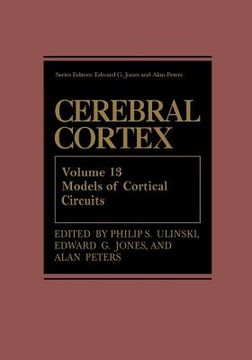Share
Cerebral Cortex: Models of Cortical Circuits
Ulinski, Philip S. (Author)
·
Springer
· Paperback
Cerebral Cortex: Models of Cortical Circuits - Ulinski, Philip S.
Choose the list to add your product or create one New List
✓ Product added successfully to the Wishlist.
Go to My Wishlists
Origin: U.S.A.
(Import costs included in the price)
It will be shipped from our warehouse between
Friday, August 09 and
Wednesday, August 21.
You will receive it anywhere in United Kingdom between 1 and 3 business days after shipment.
Synopsis "Cerebral Cortex: Models of Cortical Circuits"
Thisisthefirstvolumeinthe CerelJral Cortexseriesdevotedtomathematicalmodels ofthecortex. Itwasmotivatedbytherealizationthatcomputationalmodelsof individualneuronsandensemblesofneuronsareincreasinglyusedinresearchon corticalorganizationandfunction. Thisis, inpart, becauseofthenowubiquitous presenceofpowerfulandaffordablecomputers. Suitablemachineswereformerly rareinresearchlaboratoriesandrequiredsubstantialprogrammingexpertisetobe usedinconstructingandusingneuronalmodels. However, computersarenow routinelyusedinallareasofneurobiologyandanumberofsoftwarepackagesallow scientistswithminimalcomputerscienceandmathematicalbackgroundstocon- structseriousneuronalmodels. Asecondfactorleadingtotheproliferationof modelingstudiesisthedevelopmentoftechnologiesthatallowthekindsofdata collectionneededtodeveloprealisticmodelsofcorticalneurons. Characterization ofthekineticsofvoltage-andligand-gatedchannelsandreceptorshadbeenlim- itedtorelativelylargeneurons. However, therapiddevelopmentofsliceprepara- tions, patch-clampmethods, andimagingmethodsbasedonvoltage-sensitivedyes andintracellularcalciumindicatorshasresultedinasignificantdatabaseonthe biophysicalfeaturesofcorticalneurons.Thescopeofmodelingapproachestocorticalneuronsandfunctionsiswide anditseemednecessarytolimitthepurviewofthevolume. Thefocusisonattempts tounderstandthepropertiesofindividualcorticalneuronsandneuronalcircuitry throughmodelsthatincorporatesignificantfeaturesofcellularmorphologyand physiology. Noattemptwasmadetoincludemodelingapproachestounderstanding corticaldevelopmentandplasticity. Thus, workdealingwiththedevelopmentof oculardominancecolumnsandtheorientationselectivityofneuronsinvisualcortex isnotconsidered. Similarly, modelsdealingwiththecellularmechanismsunderlying long-termplasticityandwithapproachestolearningandmemorybasedonmodifica- tionofHebbiansynapsesarenotconsidered. Relativelyabstractattemptstounder- standhigherlevelandcognitiveprocessesbasedonneuralnetsrepresentasecond, majorareaofworkthatisnottreated. Modelsofcognitiveprocessesbasedon dynamicalsystemsmethodsinwhichnoattemptismadetoincludethebiophysical featuresofindividualneuronsarealsonotconsidered. vii viii Thetenmajorchaptersfallintothreegroups. Thefirstgroupdealswith compartmentalmodelsofindividualcorticalneurons.LyleBorg-Grahamprovides PREFACE anintroductiontothemethodsinvolvedinconstructingcompartmentalmodels andthenreviewstheexistingmodelsofhippocampalpyramidalcells. Becauseof theeffectivenessofhippocampalslicepreparations, theseneuronshavewell-ehar- acterizedbiophysicalproperties. Thischapterillustrateshowcompartmentalmod- elscanbeusedtosynthesizeexperimentaldataandprovideanintegrativeviewof thepropertiesofindividualneurons. PaulRhodescontinuesthethemebyfocusing ontheroleofvoltage-gatedchannelslocatedonthedendritesofcorticalneurons. Thisisanareainwhichtechnologicaladvancesinthevisualizationofneuronsin slicepreparationsbasedoninfraredmicroscopyhavegreatlyexpandedtheinfor- mationavailableondendriticfunctioninjustafewyears. Thechapterbothreviews theexperimentaldataonactivedendriticconductancesandemphasizestheirpo- tentialfunctionalroles. Thesecondgroupofchaptersdealwiththegenerationofreceptivefield propertiesofneuronswithinvisualcortex. Theyaddressissuesstemmingfromthe originalattempttounderstandhowthereceptivefieldpropertiesofneuronsincat andmonkeyprimaryvisualcortexaregeneratedbyinteractionsbetweengenicu- lateafferentsandcorticalneurons.ThechapterbyFlorentinWorgotterevaluates modelsthathavebeenusedtoanalyzethegenerationofreceptivefieldproperties. RodneyDouglasandhiscolleaguesaddressaspecificsetofissuesdealingwiththe roleofintracorticalexcitationmediatedbypyramidalcellcollaterals. Animportant featureofthischapterisitsrelationtoattempttoconstructfabricatedcircuitsthat duplicatethefunctionsofcorticalcircuits. ThechapterbyPhilipUlinskifocuseson thegenerationofmotion-selectivepropertiesincorticalneurons. Itseekstoidenti- tycellularmechanismsusedbyneuronsthatrespondpreferentiallytovisualstimuli movingwithparticularspeedsordirections. MatteoCarandiniandhiscolleagues discussthefeatureofcorticalneurons, knownasgaincontrol, thatallowsneurons torespondeffectivelytovisualstimulibypoolinginformationacrosspopulationsof corticalneurons. ThechapterbyHughWilsondealswiththereceptivefieldproper- tiesofextrastriateareasandintroducesnewworkanalyzingface-selectiveneurons. Thefinalsetofchaptersconsidermodelsofensemblesofthalamicandcortical neurons. ThechapterbyWilliamLyttonandElizabethThomasusesthetheoryof dynamicalsystemstoanalyzethetemporalrelationshipsbetweenthalamicand corticalneurons.Animportantfeatureoftheinteractionbetweenthalamusand cortexisthepresenceofoscillationsthatdependinpartuponthevoltage-gated conductancespresentonindividualneuronsandinpartonthestructureofthe overallnetwork. PaulBushcontinuesthisemphasisonoscillationsbydiscussinga modelthatdealswiththegenerationofsynchronizedoscillationsinvisualcortex. Oscillationsofthiskindhaveattractedsubstantialattentioninrecentyearsbecause oftheirpotentialroleincognitiveprocesses. Thelastchapter, byMichaelHasselmo andChristianeLinster, reviewstheirworkonmodelingpiriformcortex, emphasiz- ingtheroleofcholinergicmechanismsinmodulatingtheactivityofcorticalneu- rons. Anattempthasbeenmadethroughouttomakethevolumeaccessibleto readerswithminimalmathematicalbackgrounds. Thevolumethusbeginswitha shorthistoryofmodelsofcorticalneuronsandcircuitrythatintroducestheprinci- palmodelingstyles. ThechaptersbyWorgotterandUlinskicontainmoreextensive ix introductionstosomeofthemodelingmethodsthathavebeenusedtostudyvisual cortex, andthemathematicallychallengedreaderwillfindthatthechapterby PREFACE LyttonandThomascontainsareadableintroductiontotheuseofdynamical systemstheoryinneurobiology. PhilipS. Ulinski EdwardG.Jones Chicago and Davis Contents Chapter 1 ModelingCorticalCircuitry: AHistoryandProspectus PhilipS. Ulinski 1. Introduction ...1 2. LorentedeNothroughDynamicalSystemsModels...2 2. 1. LorentedeNo...2 2. 2. CellAssembliesandNeuralNets...3 2. 3.
- 0% (0)
- 0% (0)
- 0% (0)
- 0% (0)
- 0% (0)
All books in our catalog are Original.
The book is written in English.
The binding of this edition is Paperback.
✓ Producto agregado correctamente al carro, Ir a Pagar.

